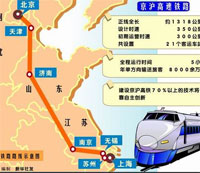Shanghai Beijing High-Speed Railway
Shanghai Beijing High-Speed Railway, also known as Jinghu High-Speed Railway, is a 1,318-kilometer railway that connects Beijing with Shanghai. The project aims to cut the journey time between the two cities from 10 hours to four hours. It will also connect the two economic zones—the Pan Bohai Bay area in the north and the Yangtze River Delta region in the south.
The laying of the tracks was completed on November 15, 2010. The project, with an investment totaled to 220.9 billion yuan (US$ 33.3 billion), is scheduled to put into use in 2012. When completed, it will become the longest high-speed railway in the world.
China currently has several high speed railways, including lines linking Beijing to Tianjin, Shanghai to Hangzhou and Wuhan to Guangzhou, extending the in-service high-speed railway network to 7,431 kilometers, Xinhua reported. According to the Ministry of Commerce, by the year of 2012, China will have a railway network of 110,000 kilometers, with 13,000 kilometers of high-speed railways.
Experts’ opinions are divided on the idea of the rapid expansion of high-speed railways. Zhen Feng, a professor at Nanjing University, said the advancement of transportation always results in economic development, improved division of labor, and a more balanced development between regions. Yet a report from the China Academy of Science (CAS), one of the top think-tanks in the country, predicted the loans may not be sustainable to support the rapid expansion of the rail network. The acceleration of investment in infrastructures may cause disruption to transport services across the country, leaving highways, subways, train stations and airports without proper connections.
